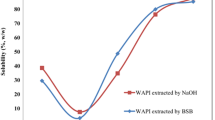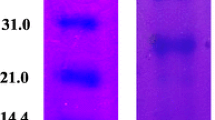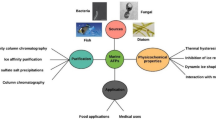Abstract
Antifreeze proteins (AFPs) were extracted from cold-acclimated oat by vacuum infiltration–centrifugation. Ammonium precipitation, ion exchange, and size-exclusion chromatography were used successively to purify the oat AFPs (AsAFPs), and the proteins were identified using matrix-assisted laser desorption/ionization time of flight tandem mass spectrometry. The results showed that an ammonium-sulfate saturation of 50–100 % was optimal for supernatant precipitation. After purification, AsAFP was found to have achieved an electrophoretic purity and its thermal-hysteresis activity was measured at 1.24 °C (15 mg ml−1). The mass fingerprinting and sequencing results indicated the homology of AsAFP and endochitinase. Recrystallization and melting resistance of ice cream were improved by AsAFP (0.1 %). Moreover, the addition of AsAFP (0.1 %) in ice cream increased the glass transition temperature (Tg) from −29.14 to −27.74 °C.







Similar content being viewed by others
Abbreviations
- AFPs:
-
Antifreeze proteins
- THA:
-
Thermal-hysteresis activity
- DSC:
-
Differential scanning calorimeter
- PBS:
-
Phosphate-buffered saline solution
- DEAE:
-
Diethylaminoethyl cellulose
- SDS-PAGE:
-
Sodium dodecyl sulfate polyacrylamide gel electrophoresis
- RIA:
-
Recrystallization inhibition activity
References
Ablett, S., Clarke, C. J., Izzard, M. J., & Martin, D. R. (2002). Relationship between ice recrystallisation rates and the glass transition in frozen sugar solutions. Journal of the Science of Food and Agriculture, 82(15), 1855–1859.
Adapa, S., Schmidt, K. A., Jeon, I. J., Herald, T. J., & Flores, R. A. (2000). Mechanisms of ice crystallization and recrystallization in ice cream: a review. Food Reviews International, 16(3), 259–271.
Altschul, A. M., Yatsu, L. Y., Orya, R. L., & Engleman, E. M. (1966). Seed proteins. Annual Review of Plant Physiology, 17(1), 113–136.
Amornwittawat, N., Wang, S., Duman, J. G., & Wen, X. (2008). Polycarboxylates enhance beetle antifreeze protein activity. Biochimica Et Biophysica Acta-Proteins and Proteomics, 1784(12), 1942–1948.
Antikainen, M., & Griffith, M. (1997). Antifreeze protein accumulation in freezing-tolerant cereals. Physiologia Plantarum, 99(3), 423–432.
Atici, O., & Nalbantoglu, B. (2003). Antifreeze proteins in higher plants. Phytochemistry, 64(7), 1187–1196.
Cao, H., Zhao, Y., Zhu, Y. B., Xu, F., Yu, J. S., & Yuan, M. (2016). Antifreeze and cryoprotective activities of ice-binding collagen peptides from pig skin. Food Chemistry, 194, 1245–1253.
Ding, X. L., Zhang, H., Liu, W. H., Wang, L., Qian, H. F., & Qi, X. G. (2014). Extraction of carrot (Daucus carota) antifreeze proteins and evaluation of their effects on frozen white salted noodles. Food and Bioprocess Technology, 7(3), 842–852.
Ding, X. L., Zhang, H., Chen, H. Y., Wang, L., Qian, H. F., & Qi, X. G. (2015a). Extraction, purification and identification of antifreeze proteins from cold acclimated malting barley (Hordeum vulgare L.). Food Chemistry, 175, 74–81.
Ding, X. L., Zhang, H., Wang, L., Qian, H. F., Qi, X. G., & Xiao, J. H. (2015b). Effect of barley antifreeze protein on thermal properties and water state of dough during freezing and freeze-thaw cycles. Food Hydrocolloids, 47, 32–40.
Duman, J. G., & Olsen, T. M. (1993). Thermal hysteresis protein-activity in bacteria, fungi, and phylogenetically diverse plants. Cryobiology, 30(3), 322–328.
Duman, J. G., & Serianni, A. S. (2002). The role of endogenous antifreeze protein enhancers in the hemolymph thermal hysteresis activity of the beetle Dendroides canadensis. Journal of Insect Physiology, 48(1), 103–111.
Feeney, R. E., & Yeh, Y. (1998). Antifreeze proteins: current status and possible food uses. Trends in Food Science & Technology, 9(3), 102–106.
Fei, Y. B., Cao, P. X., Gao, S. Q., Wang, B., Wei, L. B., Zhao, J., Chen, G., & Wang, B. H. (2008). Purification and structure analysis of antifreeze proteins from ammopiptanthus mongolicus. Preparative Biochemistry & Biotechnology, 38(2), 179–190.
Gaukel, V., Leiter, A., & Spiess, W. E. L. (2014). Synergism of different fish antifreeze proteins and hydrocolloids on recrystallization inhibition of ice in sucrose solutions. Journal of Food Engineering, 141, 44–50.
Goff, H. D., Caldwell, K. B., Stanley, D. W., & Maurice, T. J. (1993). The influence of polysaccharides on the glass-transition in frozen sucrose solutions and ice-cream. Journal of Dairy Science, 76(5), 1268–1277.
Graham, L. A., Liou, Y.-C., Walker, V. K., & Davies, P. L. (1997). Hyperactive antifreeze protein from beetles. Nature, 388(6644), 727–728.
Griffith, M., & Ewart, K. V. (1995). Antifreeze proteins and their potential use in frozen foods. Biotechnology Advances, 13(3), 375–402.
Hagiwara, T., & Hartel, R. W. (1996). Effect of sweetener, stabilizer, and storage temperature on ice recrystallization in ice cream. Journal of Dairy Science, 79(5), 735–744.
Hansen, T. N., & Baust, J. G. (1988). Differential scanning calorimetric analysis of antifreeze protein activity in the common mealworm, Tenebrio molitor. Biochimica et Biophysica Acta (BBA) - Protein Structure and Molecular Enzymology, 957(2), 217–221.
Higgins, T. J. V. (1984). Synthesis and regulation of major proteins in seeds. Annual Review of Plant Physiology, 35(1), 191–221.
Hon, W. C., Griffith, M., Chong, P. L., & Yang, D. S. C. (1994). Extraction and isolation of antifreeze proteins from winter rye (Secale-Cereale L) leaves. Plant Physiology, 104(3), 971–980.
Knight, C. A., Cheng, C. C., & Devries, A. L. (1991). Adsorption of alpha-helical antifreeze peptides on specific ice crystal-surface planes. Biophysical Journal, 59(2), 409–418.
Kristiansen, E., & Zachariassen, K. E. (2005). The mechanism by which fish antifreeze proteins cause thermal hysteresis. Cryobiology, 51(3), 262–280.
Kuiper, M. J., Davies, P. L., & Walker, V. K. (2001). A theoretical model of a plant antifreeze protein from Lolium perenne. Biophysical Journal, 81(6), 3560–3565.
Li, Y. P., Gong, H., & Park, H. Y. (2000). Purification and partial characterization of thermal hysteresis proteins from overwintering larvae of pine needle gall midge, Thecodiplosis japonensis (Diptera : Cecidomiidae). Cryo-Letters, 21(2), 117–124.
Muse, M. R., & Hartel, R. W. (2004). Ice cream structural elements that affect melting rate and hardness. Journal of Dairy Science, 87(1), 1–10.
Pertaya, N., Marshall, C. B., Celik, Y., Davies, P. L., & Braslavsky, I. (2008). Direct visualization of spruce budworm antifreeze protein interacting with ice crystals: basal plane affinity confers hyperactivity. Biophysical Journal, 95(1), 333–341.
Regand, A., & Goff, H. D. (2005). Freezing and ice recrystallization properties of sucrose solutions containing ice structuring proteins from cold-acclimated winter wheat grass extract. Journal of Food Science, 70(9), E552–E556.
Shewry, P. R., Napier, J. A., & Tatham, A. S. (1995). Seed storage proteins—structures and biosynthesis. Plant Cell, 7(7), 945–956.
Sidebottom, C., Buckley, S., Pudney, P., Twigg, S., Jarman, C., Holt, C., Telford, J., McArthur, A., Worrall, D., Hubbard, R., & Lillford, P. (2000). Phytochemistry—heat-stable antifreeze protein from grass. Nature, 406(6793), 256–256.
Soukoulis, C., Lebesi, D., & Tzia, C. (2009). Enrichment of ice cream with dietary fibre: effects on rheological properties, ice crystallisation and glass transition phenomena. Food Chemistry, 115(2), 665–671.
Urrutia, M. E., Duman, J. G., & Knight, C. A. (1992). Plant thermal hysteresis proteins. Biochimica Et Biophysica Acta, 1121(1–2), 199–206.
Wang, L., & Duman, J. G. (2006). A thaumatin-like protein from larvae of the beetle Dendroides canadensis enhances the activity of antifreeze proteins. Biochemistry, 45(4), 1278–1284.
Wang, S., Agyare, K., & Damodaran, S. (2009). Optimisation of hydrolysis conditions and fractionation of peptide cryoprotectants from gelatin hydrolysate. Food Chemistry, 115(2), 620–630.
Wang, X., Bian, Y. Y., Cheng, K., Zou, H. F., Sun, S. S. M., & He, J. X. (2012). A comprehensive differential proteomic study of nitrate deprivation in Arabidopsis reveals complex regulatory networks of plant nitrogen responses. Journal of Proteome Research, 11(4), 2301–2315.
Wilson, P. W. (1993). Explaining thermal hysteresis by the Kelvin effect. Cryo-Letters, 14(1), 31–36.
Worrall, D., Elias, L., Ashford, D., Smallwood, M., Sidebottom, C., Lillford, P., Telford, J., Holt, C., & Bowles, D. (1998). A carrot leucine-rich-repeat protein that inhibits ice recrystallization. Science, 282(5386), 115–117.
Wu, J. H., Rong, Y. Z., Wang, Z. W., Zhou, Y. F., Wang, S. Y., & Zhao, B. (2015). Isolation and characterisation of sericin antifreeze peptides and molecular dynamics modelling of their ice-binding interaction. Food Chemistry, 174, 621–629.
Yu, X. M., & Griffith, M. (2001). Winter rye antifreeze activity increases in response to cold and drought, but not abscisic acid. Physiologia Plantarum, 112(1), 78–86.
Zachariassen, K. E., & Husby, J. A. (1982). Antifreeze effect of thermal hysteresis agents protects highly supercooled insects. Nature, 298(5877), 865–867.
Zachariassen, K. E., DeVries, A. L., Hunt, B., & Kristiansen, E. (2002). Effect of ice fraction and dilution factor on the antifreeze activity in the hemolymph of the cerambycid beetle Rhagium inquisitor. Cryobiology, 44(2), 132–141.
Zhang, D. Q., Liu, B., Feng, D. R., He, Y. M., & Wang, J. F. (2004). Expression, purification, and antifreeze activity of carrot antifreeze protein and its mutants. Protein Expression and Purification, 35(2), 257–263.
Zhang, C., Zhang, H., Wang, L., Zhang, J. H., & Yao, H. Y. (2007). Purification of antifreeze protein from wheat bran (Triticum aestivum L.) based on its hydrophilicity and ice-binding capacity. Journal of Agricultural and Food Chemistry, 55(19), 7654–7658.
Zhang C, Zhao, X., Ma, Y., Zhang, H., & Yao, H. Y. (2008) Determination of thermal hysteresis activity of antifreeze protein by differential scanning calorimetry. Acta Biophysica Sinica. 24(6).
Zhang, C., Ma, Y., Zhao, X. Y., Zhang, H., & Yao, H. Y. (2009). Determination of primary structure of winter-wheat-bran antifreeze protein. Chinese Journal of Analytical Chemistry, 37(5), 659–664.
Zhang, Y. J., Zhang, H., Wang, L., Qian, H. F., & Qi, X. G. (2015). Extraction of oat (Avena sativa L.) antifreeze proteins and evaluation of their effects on frozen dough and steamed bread. Food and Bioprocess Technology, 8(10), 2066–2075.
Acknowledgments
Financial support from the National Natural Science Foundation of China (No. 31171637) is gratefully acknowledged.
Author information
Authors and Affiliations
Corresponding author
Rights and permissions
About this article
Cite this article
Zhang, Y., Zhang, H., Ding, X. et al. Purification and Identification of Antifreeze Protein From Cold-Acclimated Oat (Avena sativa L.) and the Cryoprotective Activities in Ice Cream. Food Bioprocess Technol 9, 1746–1755 (2016). https://doi.org/10.1007/s11947-016-1750-x
Received:
Accepted:
Published:
Issue Date:
DOI: https://doi.org/10.1007/s11947-016-1750-x




